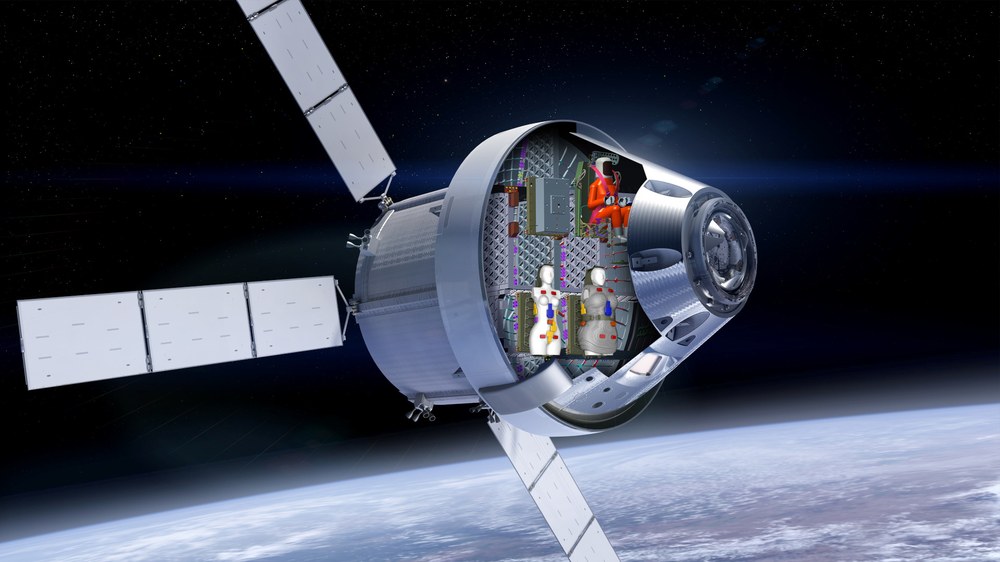The MARE cosmic radiation experiment on board Artemis I


Your consent to the storage of data ('cookies') is required for the playback of this video on Youtube.com. You can view and change your current data storage settings at any time under privacy.

Outside Earth's protective magnetic field, radiation exposure is very high for humans. It poses a considerable health risk for future crews on long-term missions to the Moon and Mars. That is why it is crucial to determine this exposure more precisely and to develop measures to protect astronauts. The Matroshka AstroRad Radiation Experiment (MARE) used two identical mannequins, which flew to the Moon on board NASA's Artemis I mission, to investigate radiation exposure during the entire flight.
The twin test mannequins are modelled on female physiology. One of them – Helga – flew to the Moon unprotected; the other – Zohar – wore a newly developed radiation protection vest. The vest covers the upper body, the uterus and the blood-forming organs. By comparing the two sets of data, it is possible to determine the extent to which the vest would protect a female astronaut from harmful radiation exposure.
Helga and Zohar – two phantom astronauts measure radiation exposure on a journey to the Moon
The two 'phantoms' each consist of 38 discs are 95 centimetres tall and weigh 36 kilograms. Zohar weighs 62 kilograms with the protective vest. Inside them are organs and bones made of plastics of varying density. More than 6000 passive radiation detectors made of small crystals are installed there and on the surface, and 16 active detectors on the body's most radiation-sensitive organs – lungs, stomach, uterus and bone marrow. The passive radiation measuring devices (dosimeters) measure continuously and thus provide a value of the radiation over the entire mission duration. By retrieving the information from the crystals, a three-dimensional image of the human body can be created, which shows how high the total radiation exposure is on bones and organs in different places during a flight to the Moon and back.
The active, battery-operated detectors also record the current radiation exposure with a temporal resolution of five minutes. This allows the scientists to understand how radiation exposure affects the body parts under different conditions and mission phases.
MARE is also the first to measure the radiation exposure to the female body beyond the orbit of the International Space Station ISS. The female body is more sensitive to the effects of ionising radiation than the male body. It is therefore important to develop protective measures for the crews of future long-term missions based on this data. Zohar, contributed by the Israel Space Agency, flew to the Moon with a protective vest (AstroRad) made by the Israeli company StemRad, while Helga flew without any protection. In this way, the identical models collected comparable data sets. A total of more than 6000 passive measurement sensors were placed both on the surface of and inside the 'phantoms'. After the flight around the Moon, the radiation values measured by both models are compared in order to evaluate the effectiveness of the AstroRad protective vest.
For the first time, MARE also continuously collected measurement data that can be used to determine the radiation exposure inside the spacecraft at specific times during the flight to the Moon. This was achieved using, among other things, 16 radiation measuring instruments developed by DLR – the DLR M-42.
Measuring cosmic radiation on the ISS
The radiation levels to which the male and female astronauts on board the ISS are exposed have been studied for years at the DLR Institute of Aerospace Medicine. In 2004, a 'male' mannequin (Matroshka) was attached to the exterior of the ISS for one and a half years to determine how high the radiation exposure is during extravehicular activities. It was later used to measure cosmic radiation inside various modules of the ISS. The DLR experiment DOSIS 3D has been measuring radiation in the Columbus laboratory since 2012. The results are being used to create a 3D model of radiation exposure on the International Space Station.
During the Artemis I mission, the Orion spacecraft travelled almost 500,000 kilometres from Earth – further than any crewed spacecraft has ever flown. These are the best conditions for collecting a lot of data with the help of the test mannequins, which will make similar journeys safe for future human crews.
MARE – the most extensive radiation exposure experiment to leave low-Earth orbit
The MARE experiment is led by DLR. The main project partners are the Israeli Space Agency (ISA), the Israeli company StemRad, which developed the AstroRad protective vest, Lockheed Martin and NASA. Due to its complexity and the scale of international collaboration with many different universities and research institutions in Europe, Japan and the USA, MARE is the largest experiment designed to determine radiation exposure for astronauts that has ever flown beyond low-Earth orbit. The measurements during Artemis I provide fundamental data for assessing the radiation risk and enabling safe human exploration of space.
Multimedia

